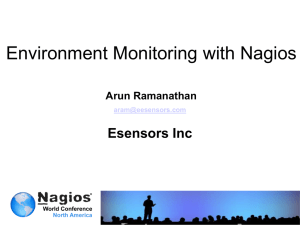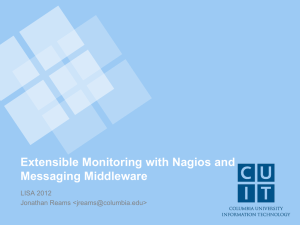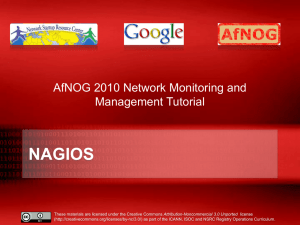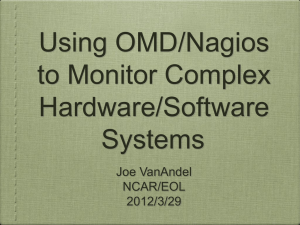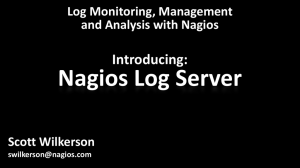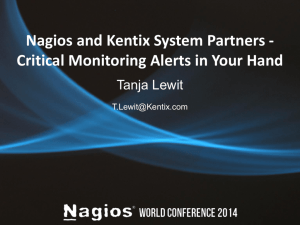Document
advertisement
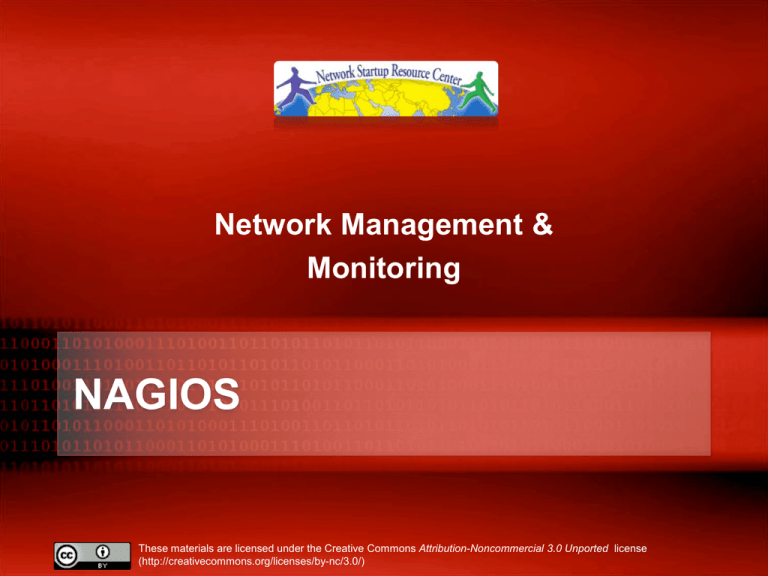
Network Management &
Monitoring
NAGIOS
These materials are licensed under the Creative Commons Attribution-Noncommercial 3.0 Unported license
(http://creativecommons.org/licenses/by-nc/3.0/)
Introduction
Network Monitoring Tools
Availability
Reliability
Performance
Nagios actively monitors the availability of
devices and services
Introduction
Possibly the most used open source network
monitoring software.
Has a web interface.
Uses CGIs written in C for faster response and
scalability.
Can support up to thousands of devices and
services.
Installation
In Debian/Ubuntu
# apt-get install nagios3
Key directories
/etc/nagios3
/etc/nagios3/conf.d
/etc/nagios-plugins/conf
/usr/lib/nagios/plugins
/usr/share/nagios3/htdocs/images/logos
Nagios web interface is here:
http://YourMachine/nagios3/
Plugins
Plugins are used to verify services and devices:
Nagios architecture is simple enough that writing new
plugins is fairly easy in the language of your choice.
There are many, many plugins available (thousands).
http://exchange.nagios.org/
http://nagiosplugins.org/
Features
Configuration done in text files, based on
templates.
Nagios reads its configuration from a directory.
You determine how to divide your configuration
files.
Uses parallel checking and forking for scalability
Features cont.
Utilizes topology to determine dependencies.
Differentiates between what is down vs. what is
unreachable. Avoids running unnecessary checks
and sending redundant alarms
Allows you to define how to send notifications
based on combinations of:
Contacts and lists of contacts
Devices and groups of devices
Services and groups of services
Defined hours by persons or groups.
The state of a service.
Notification Options (Host)
Host state:
When configuring a host you have the
following notification options:
– d:
– u:
– r:
– f:
– n:
DOWN
UNREACHABLE
RECOVERY
FLAPPING
NONE
How checks work
A node/host/device consists of one or more service checks
(PING, HTTP, MYSQL, SSH, etc.)
Periodically Nagios checks each service for each node
and determines if state has changed. State changes are:
CRITICAL
WARNING
UNKNOWN
For each state change you can assign:
Notification options (as mentioned before)
Event handlers
How checks work continued
Parameters
Normal checking interval
Re-check interval
Maximum number of checks.
Period for each check
Node checks only happen when services
respond.
A node can be:
DOWN
UNREACHABLE
How checks work continued
• By default Nagios does a node check 3 times
before it will change the node’s state to down.
• No response states goes to warning then
critical
The concept of “parents”
Nodes can have parents:
• The parent of a PC connected to a switch would be
the switch.
• Allows us to specify the dependencies between
devices.
• Avoids sending alarms when parent does not
respond.
• A node can have multiple
parents (dual homed).
Network viewpoint
• Where you locate your Nagios server will
determine your point of view of the network.
• The Nagios server becomes the “root” of your
dependency tree
Network viewpoint
Demo Nagios
Configuration Files
• Lots!
• Can seem complex at first
• Object oriented
- Objects (devices or services) inherit
attributes.
- Apply functionality to groups of devices.
- Do not apply functionality to individual
objects. Does not scale!
- Once you understand Nagios configs the
rest is easy…
Configuration files (Official)
Configuration Files
Located in /etc/nagios3/
Important files include:
cgi.cfg
Controls the web interface and
security options.
commands.cfg The commands that Nagios uses
for notifications.
nagios.cfg
Main configuration file.
conf.d/*
All other configuration goes here!
Configuration files continued
Under conf.d/*
contacts_nagios2.cfg
extinfo_nagios2.cfg
generic-host_nagios2.cfg
generic-service_nagios2.cfg
host-gateway_nagios3.cfg
hostgroups_nagios2.cfg
localhost_nagios2.cfg
services_nagios2.cfg
timeperiods_nagios2.cfg
users and groups
make your UI pretty
default host template
default service template
host at default gw definition
groups of nodes
definition of nagios host
what services to check
when to check who to notify
Configuration files continued
Under conf.d some other possible config files:
servicegroups.cfg
pcs.cfg
switches.cfg
routers.cfg
Groups of nodes and services
Sample definition of PCs (hosts)
Definitions of switches (hosts)
Definitions of routers (hosts)
Pre-installed plugins in Ubuntu
/usr/lib/nagios/plugins
/etc/nagios-plugins/config
Nodes and services configuration
Based on templates
This saves lots of time avoiding repetition
Similar to Object Oriented programming
Create default templates with default
parameters for a:
generic node
generic service
generic contact
Generic node template
define host{
name
generic-host ; The name of this host template
notifications_enabled
1
; Host notifications are enabled
event_handler_enabled
1
; Host event handler is enabled
flap_detection_enabled
1
; Flap detection is enabled
failure_prediction_enabled 1
; Failure prediction is enabled
process_perf_data
1
; Process performance data
retain_status_information
1
; Retain status information across program restarts
retain_nonstatus_information 1
; Retain non-status information across program restarts
check_command
check-host-alive
max_check_attempts
10
notification_interval
0
notification_period
24x7
notification_options
d,u,r
contact_groups
admins
register
0
; DONT REGISTER THIS DEFINITION - ITS NOT A REAL HOST, JUST A TEMPLATE!
}
Individual node configuration
define host{
use
host_name
alias
address
contact_groups
}
generic-host
gw-rtr
Main workshop router
192.0.2.1
router_group
Generic service configuration
define service{
name
active_checks_enabled
passive_checks_enabled
parallelize_check
obsess_over_service
check_freshness
notifications_enabled
event_handler_enabled
flap_detection_enabled
process_perf_data
retain_status_information
retain_nonstatus_information
is_volatile
check_period
max_check_attempts
normal_check_interval
retry_check_interval
notification_interval
notification_period
notification_options
register
}
generic-service
1
1
1
0
1
1
1
1
1
1
1
0
24x7
5
5
1
60
24x7
c,r
0
Individual service configuration
define service{
hostgroup_name
servers
service_description
PING
check_command
check-host-alive
use
generic-service
max_check_attempts
5
normal_check_interval
5
notification_options
c,r,f
notification_interval
0 ; set > 0 if you want to be renotified
}
c: Critical
r: Recovering
f: Flapping
Configuration Flow
Items inherit from templates
We start with a host
- Place multiple hosts in a group
- Define parents
- Add a service check to the group
- Add extended info, if any
OoB Notifications
A critical item to remember: an SMS or message
system that is independent from your network.
You can utilize a cell phone connected to the
Nagios server
You can use packages like:
gnokii:
http://www.gnokii.org/
qpage:
http://www.qpage.org/
sendpage: http://www.sendpage.org/
References
• Nagios web site
http://www.nagios.org/
• Nagios plugins site
http://www.nagiosplugins.org/
• Nagios System and Network Monitoring, by
Wolfgang Barth. Good book about Nagios.
• Unofficial Nagios plugin site
http://nagios.exchange.org/
• A Debian tutorial on Nagios
http://www.debianhelp.co.uk/nagios.htm
• Commercial Nagios support
http://www.nagios.com/
Questions?
?
Additional Details
A few additional slides you may find useful or
informative…
Features, features, features…
• Allows you to acknowledge an event.
- A user can add comments via the GUI
• You can define maintenance periods
- By device or a group of devices
• Maintains availability statistics.
• Can detect flapping and suppress additional notifications.
• Allows for multiple notification methods:
- e-mail, pager, SMS, winpopup, audio, etc...
• Allows you to define notification levels for escalation
Main configuration details
Global settings
File: /etc/nagios3/nagios.cfg
• Says where other configuration files are.
• General Nagios behavior:
For large installations you should tune the
installation via this file.
-
See: Tunning Nagios for Maximum Performance
http://nagios.sourceforge.net/docs/2_0/tuning.html
CGI configuration
/etc/nagios3/cgi.cfg
You can change the CGI directory if you wish
Authentication and authorization for Nagios use:
Activate authentication via Apache's .htpasswd mechanism, or
using RADIUS or LDAP.
Users can be assigned rights via the following variables:
authorized_for_system_information
authorized_for_configuration_information
authorized_for_system_commands
authorized_for_all_services
authorized_for_all_hosts
authorized_for_all_service_commands
authorized_for_all_host_commands
Time Periods
This defines the base periods that control checks,
notifications, etc.
Defaults: 24 x 7
Could adjust as needed, such as work-week only.
Could adjust a new time period for “outside of regular
hours”, etc.
# '24x7'
define timeperiod{
timeperiod_name
alias
sunday
monday
tuesday
wednesday
thursday
friday
saturday
}
24x7
24 Hours A Day, 7 Days A Week
00:00-24:00
00:00-24:00
00:00-24:00
00:00-24:00
00:00-24:00
00:00-24:00
00:00-24:00
Configuring service/host checks:
Definition of “host alive”
# 'check-host-alive' command definition
define command{
command_name check-host-alive
command_line $USER1$/check_ping -H $HOSTADDRESS$ -w 2000.0,60% -c
5000.0,100% -p 1 -t 5
}
• Located in /etc/nagios-plugins/config, then adjust in /etc/nagios3/conf.d/
services_nagios2.cfg
• While these are “service” or “host” checks Nagios refers to them as
“commands”
Notification commands
Allows you to utilize any command you wish.
We could use this to generate tickets in RT.
# 'notify-by-email' command definition
define command{
command_name
notify-by-email
command_line
/usr/bin/printf "%b" "Service: $SERVICEDESC$\nHost:
$HOSTNAME$\nIn: $HOSTALIAS$\nAddress: $HOSTADDRESS$\nState:
$SERVICESTATE$\nInfo: $SERVICEOUTPUT$\nDate: $SHORTDATETIME$" | /bin/mail -s
'$NOTIFICATIONTYPE$: $HOSTNAME$/$SERVICEDESC$ is $SERVICESTATE$'
$CONTACTEMAIL$
}
From: nagios@nms.localdomain
To:
router_group@localdomain
Subject: Host DOWN alert for TLD1-RTR!
Date:
Thu, 29 Jun 2006 15:13:30 -0700
Host: gw-rtr
In: Core_Routers
State: DOWN
Address: 192.0.2.100
Date/Time: 06-29-2006 15:13:30
Info: CRITICAL - Plugin timed out after 6 seconds
Group service configuration
# check that ssh services are running
define service {
hostgroup_name
ssh-servers
service_description
SSH
check_command
check_ssh
use
generic-service
notification_interval
0 ; set > 0 if you want to be renotified
}
The “service_description” is important if you plan to create Service
Groups. Here is a sample Service Group definition:
define servicegroup{
servicegroup_name
alias
members
}
Webmail
web-mta-storage-auth
srvr1,HTTP,srvr1,SMTP,srvr1,POP,srvr1,IMAP,
srvr1,RAID,srvr1,LDAP, srvr2,HTTP,srvr2,SMTP,
srvr2,POP,srvr2,IMAP,srvr2,RAID,srvr2,LDAP
Screen Shots
A few sample screen shots from a Nagios
install.
General View
Service Detail
Host Detail
Host Groups Overview
Service Groups Overview
Collapsed tree status map
Marked-up circular status map
More sample screenshots
Many more sample
Nagios screenshots
available here:
http://www.nagios.org/about/sc
reenshots



